
2019 KEY TRENDS
Teamspirit anticipates the challenges for the year ahead
The financial services sector has never had a more critical role than the one it will play in 2019.
Amid the global political uncertainty and international jostling to host fragmenting traditional banking operations, this will be the year when the financial services sector has to take the lead to shape our future.
Despite the challenges, the sector continues to prove its adaptability, with the fintech sector still growing and the UK the investment capital in Europe. Future tech-enabled opportunities such as AI are beginning to materialise, yet highlight that transparency has never been more possible nor more at risk.
2019 is the year when how the financial services sector behaves, from the services it creates to the way it does business, will be under even greater scrutiny. Expectations from investors and consumers have never been higher. As the following trends indicate, it’s because financial services matter so much, to so many, that now it is time to lead by example.
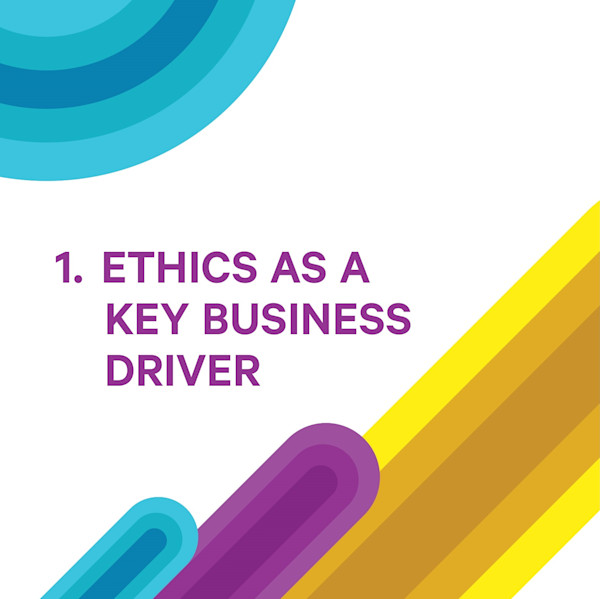
Being ethical is no longer a behind-the-scenes activity relegated to a footnote in the annual report. A year on since Larry Fink, CEO of BlackRock’s call to businesses to define their societal purpose, ethics and purpose have become a c-suite agenda that’s now driving business strategy.
Both Starling Bank and Barclays have introduced gambling blockers, to help ensure that no payments can be made to any gambling sites. It’s an example of businesses stepping up, to fill gaps in policy and to meet the sentiment of both investors and users.
The cost of not meeting ethical expectations is all too apparent. Facebook’s Cambridge Analytica scandal underlines how Facebook lost sight of its purpose and broke the implicit value proposition to its users.
Being ethical and purpose driven is creating new business models such as B Corps, who meet the highest standards of verified social and environmental performance, public transparency and legal accountability to balance profit and purpose. A growing global movement of people using business as a force for good, including such brands as Patagonia and Hootsuite, it’s a powerful way to attract and retain talent, and to win business.
Many fintechs, such as Jumo, are from inception helping create greater inclusion and equality, with a driving purpose to create a positive impact. Companies including Arabesque are using self-learning AI quant models to assess the performance and sustainability of globally listed companies, and along with Tribe Impact Capital offer UN SDGbased ethical investment, without compromising profit.
2019 will see ethics move centre stage. Good business not only makes business sense, it’s now a business necessity.
• It’s time to take a stance. Define the ethics of the business and communicate what you stand for. Take the lead, rather than being on the back foot.
• Start with purpose and ask yourself, what sort of corporate citizen do you want to be?
• Be wary of the trend wagon. Your purpose must be authentic, drive behaviour internally, and be delivered across the supply chain.

__AI is starting to transform the financial services landscape, offering as it does the ability to reduce cost, improve accuracy, prevent fraud and cut the need for that most expensive of resources, actual human beings. There’s no denying the appeal of something that can shorten claim times, drive down the costs of transactions and make the process of applying and buying, easier and more intuitive.
But AI also raises the prospect of financial service providers having the ability to cherry-pick and choose to serve only those markets and segments of markets that are most profitable and least risky for them. It’s already being used for risk analysis and to identify and stop fraudulent claims in insurance; but concerns have been raised that it is being used to improve margins by pricing out those it ‘learns’ are more likely to claim – often on the flimsiest of indicators such as a surname.
The combination of capability and autonomy it delivers, means that AI is making choices with profound consequences for customers and employees alike. Transparency is now at risk, when the complexity of the algorithms sometimes means that the answer is literally ‘because the computer says no’.
In 2019, businesses must think carefully when applying AI to their processes. Each will have to balance their need to protect margin and improve profitability, with the need to act responsibly and be able to explain how decisions are made.
• AI will continue to slash acquisition costs throughout financial services, while its predictive analytics will provide greater security.
• The complexity of the algorithms means that transparency is at risk. Companies will need to clearly evidence when introducing AI, that they are acting responsibly and for the overall good.
• Without careful consideration, AI could lead to serious societal exclusion and customer detriment issues.
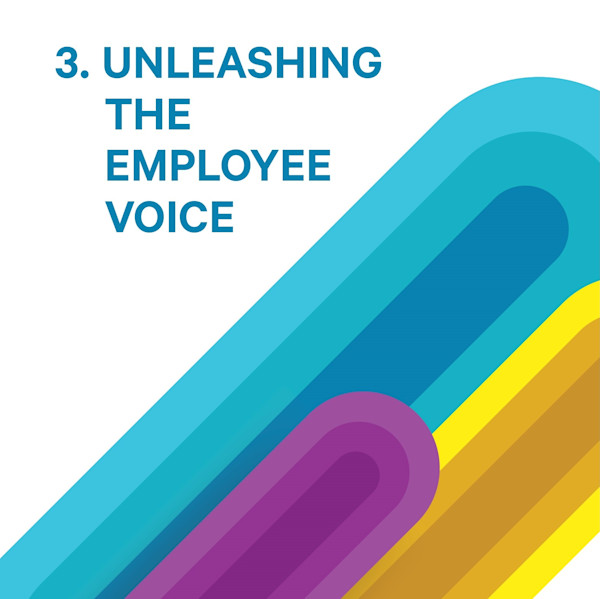
‘People first’ organisations. Along with ‘digital first’ it’s a strategy and phrase we hear again and again. From start-ups, to retailers, to tech companies and agencies, it is lauded as a way to create an environment that engenders happy people and ergo happier productivity figures. But what if putting your employees first in terms of your brand communications, in particular your social promotion, could unlock even more productivity?
Unleashing your employee voice on social can be daunting. But leading brands are doing just that – putting their employees in front of their logos, to bring a new level of authenticity, credibility and trust to their brand story. We’re not meaning the c-suite, either. We mean regular employees. Because research shows credibility is much higher with them than with communications from the CEO, MD or other senior execs.
According to the McKinsey Global Institute, “Productivity improves by 20-25% in organisations with socially connected employees.” And because employees know your business inside out, they can be more switched on and on-message social brand ambassadors than any celeb or sports star – not to mention believable and costefficient. Really, your everyday employees are a social marketing and promotional goldmine. Expect to see brands unleash their employees as their best salespeople in 2019.
• Employees are estimated to be 20-25% more productive when they socially connected.
• Putting everyday employees in front of brand communications brings more trust than CEOs.
• Your employees are your best salespeople. Let their voices be heard, by putting your employees at the forefront of your social channels.
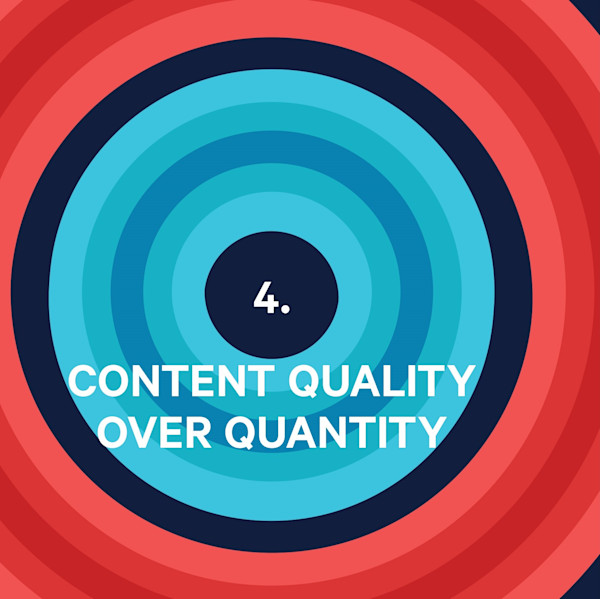
The phrase ‘content is king’ is now a well-established cliché, but its sentiment still rings true in today’s increasingly competitive, highly fragmented, omni-channel marketplace.
For brands seeking to secure that three-second ‘thumb stopping’ moment on social platforms, it’s about creating quality, differentiated content that genuinely stands out. Brands are having to compete in and outside their sector, to grab those three seconds of attention. 2019 will see a move away from the volume-based, scattergun approach, to one of better-quality content, focused placement and earned reach.
Brands are also now competing with publishers, many of whom have had to retreat behind a pay wall to ensure the continued quality of their own content. The impact of fake news and fragmentation of media will continue to drive a shift towards verified, authentic commentators. Expect to see a full-circle return to investment in quality journalism, such as the new nonpartisan, non-profit newsroom The Markup, dedicated to investigating big tech and its effect on society, helped by $20m from Craigslist founder, Craig Newmark.
In 2019 we will see the rise of quality content, which will be less frequent but better. A successful integrated marketing strategy will start with an initial piece of quality content as the jumping-off point. Creative execution and campaigning based on an earned first approach will also see brands consider different, quality media that supports their stature.
Content is still king. But like a king, it needs an authentic, relevant message and should make carefully chosen appearances in the right locations to deliver the desired impact.
• A smart, focused content strategy is vital in 2019.
• Do fewer things, but better.
• Harness omni-channel integration to maximise the value of any campaign.
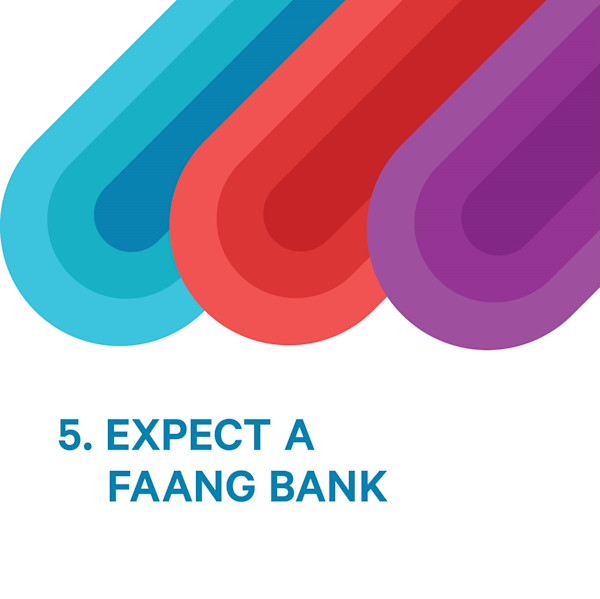
With Silicon Valley giants already offering payments, transfers, and digital wallets, the race is on between the FAANGs (the four high-performing tech stocks – Facebook, Apple, Amazon, Netflix and Google) to launch a bank.
In the last two years we have seen Facebook announce partnerships with PayPal, Amex and Citibank, allowing users to connect their social and banking accounts. Google now offers loans as a recruitment tool in the ever-growing Indian market. And through its partnership with Goldman Sachs, you can now apply for an Apple credit card, which provides an integrated consumer experience through online and high street retailing.
Amazon appears to have stolen the lead, offering credit cards with rewards, short-term loans to sellers, and trialling Amazon Cash in US stores, which allows customers to make cash deposits. More importantly, this offering supports its core business. When surveyed, 64% of Prime users said they would open a bank account if they got 2% discounts.
With the Chinese tech giant Alibaba already a top 10 global bank by market cap, surely in 2019 we can expect to see one of the tech giants finally break through to launch a bank.
• Brand is more important than ever. Existing financial service brands have to build and reinforce trust with customers, while always demonstrating their relevance and usefulness.
• Traditional banks need to deliver a distinct customer experience, in order to insulate themselves against the tech giants.
• Banks need to partner with, or acquire, tech companies, to improve their infrastructure, to allow them to offer customers the same frictionless convenience and simplicity that they have grown used to with the tech giants.
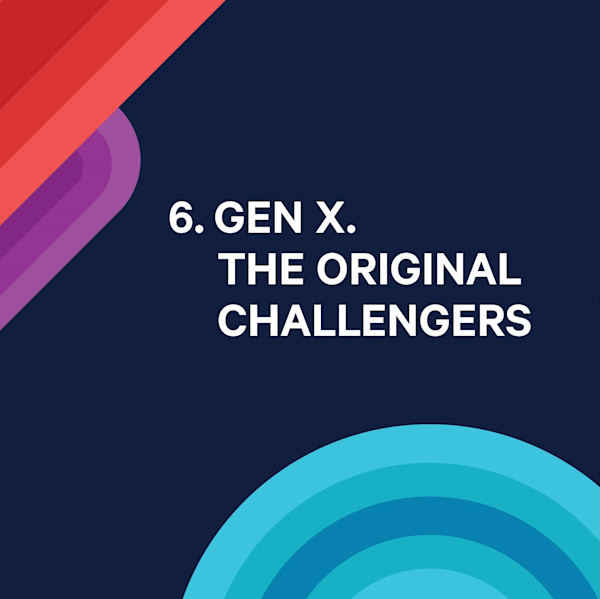
Sick of hearing about the Boomers and the Millennials? Anyone would think that there was no-one of any note born between 1963-1980ish! Welcome to Generation X, mainly known for being neglected and ignored. They were supposed to be a ‘lost generation’ - cynical, latch-key, alienated kids, doomed to live forever in the shadow of their Baby Boomer elders. They were always the generation that took things too far, challenged the mores and traditional views, had too much sex, drugs and rock and roll.
Yet, they have gone on to challenge every stage of their life, and many things that have got in their way, such as the Berlin Wall, the Watergate scandal, human rights, women’s rights, gay rights and so on.
Now, as Generation X nudges towards middle age, it’s time to admit just how much we owe to this unsung generation. As they increasingly take on the leadership roles within business, at home and in the community, you can start to imagine a more humane and pragmatic leadership that’s adaptable to the new challenges it will undoubtedly confront.
Their core values include diversity, self-reliance, practicality, informality, work/life balance, flexibility, and technology. Like other engaged workers, Gen X’ers give their best when their responsibilities in the workplace align with their values. Their performance suffers when their values are ignored.
• Generation X don’t take things lying down. Get ready to challenge the way your business provides customer experience and quality, because they will expect better.
• Recognise that this cohort will be looking for a new way to lead their team as they are more democratic, open to feedback and are introducing more transparency within organisations.
• Start thinking about the kind of areas that you can help them challenge conventions. They are interested in thought leadership that has a clear point of view and offers a different perspective.

2019 is going to be the year when brands turn to experience designers to combine the power of CX, UX and marketing automation, to deliver distinct and valued brand experiences in the round.
How consumers are informed, engaged and buy has changed radically over the past few years, and continues to be shaped in particular by their online retail experiences. Research shows that 2019 marketing budgets are flowing towards marketing tech, including both programmatic and automated communication capabilities, as well as user experience design. For marketers, this is a desire for brands to offer an enhanced and distinct customer experience.
While all these seemingly individual disciplines need to be seen in the round and not as silos, brands need to define where they can create differentiation and add distinctive value for their target audiences.
In terms of CX design, until recently experience thinking has concentred on integrating internal silo disciplines, uniting demand generation with sales and loyalty marketing around the customer, to create a seamless path to purchase and effortless experiences that generated repurchases. The problem is that every brand is trying to do the same thing.
In 2019, brands will need to make choices. Brand owners need to decide which parts of the brand experience adds real value to the customer – from next product selection to usage suggestions and robo advice – and then excel at them. Creating a Total Experience, has to be based on differentiated value.
• UX can no longer be defined in isolation from the wider total CX experience.
• Unite the silos behind sales and marketing, to create a holistic brand experience.
• Identify or create experience points that your customers find most valuable, and excel at them.

The explosive growth in the fintech sector has already prompted fundamental change in how financial service brands talk to their customers and create products and services. Agility and continual improvement have become tablestakes for any self-respecting FS brand. Now, as fintechs start to come of age and become truly major forces in the industry, we can expect to see wider adoption of some of the cultural differences upon which their businesses are built.
This doesn’t just mean that flexible working and cool benefits packages will become the new norm, but that there’ll be a comprehensive shift in the mindsets of both employees and employers. With people focusing more on what the world of work can offer them, and a general trend towards individual entrepreneurship, businesses will have to think differently to attract and keep top talent. For instance, Springboard from Octopus, gives employees four months to build their own start-up while being paid a salary and given working capital to pursue their ideas.
Another area that might see radical change, is how people are paid. The idea of a fixed salary that increases at set intervals may become outdated, and even the most established players could start to offer employees less traditional forms of remuneration, such as a stake in a business’ equity, or working capital to fund project development, inspire innovation and build a culture of loyalty.
• The entrepreneurial mindset might be stronger than company loyalty – understand and support it.
• Salary structures are as ripe for evolution as every other part of a business.
• Every work/life balance is individual and there’s no one size fits all.

As automated marketing uptake increases with the transition to more efficient and digital technologies, there has been a drive for in-house marketing departments to increase their executional capabilities to improve their speed and agility.
Concurrently as some of these commoditised areas of the marketing and sales process are taken in-house, agencies have been diversifying their business models to meet changing client needs, with many now offering on-site/in-house support, seconded support or outsourced solutions. With clients now being less reliant on agency delivery teams to run basic processes and adapt creative, it has also highlighted the need for the highly skilled teams of specialists to deliver market-leading intellectual capital and digital expertise.
A 2018 CIM digital skills benchmark report, revealed that digital competency levels in marketing departments were on average less than 40% across all disciplines and at all levels. The result is that brands are now putting the emphasis on seeking agency specialists, for roles as creative strategists, creative technologists, category specialists, innovators and specialist content creators and delivery providers. The future need in 2019 and onwards is for high-quality external resource, where specialism has never been more vital.
• Most organisations need to invest heavily and upskill basic digital skills training across the whole marketing department.
• Spend time choosing your agency partners wisely, to ensure they have the specialist and strategic skills required to support your marketing efforts.
• Be rigorous in assessing your digital toolset. At present there are over 300 martech tools in the marketplace, most of which will not be appropriate for your needs.

It takes just five seconds for an average Spotify listener to skip to the next track. Forty seconds for a person to switch from one task to another at their computer. The battle for attention, and retention, has never been more intense, and will only become more so. The combination of ceaseless technological change and an explosion in the amount of content available, means brands have to behave differently in order to drive response.
This perfect storm requires brand behaviour to become truly ‘people first’ and demonstrably ‘human’ in order to secure stand-out. This shift is driven by demand. People no longer want to hear about your digital capability, unique AI or vast processing speed. The majority of us can’t keep up with the latest technologies, let alone understand how the widget works.
Instead, the factors determining whether people engage with a brand, consume content and eventually buy, are relevance, authenticity and recommendation. Which means that, counterintuitively in a digital world, brands have to be about their humanity. This includes articulating and delivering a brand’s difference in terms of a core purpose: to tackle a friction point in order to make the world of their consumer better.
• The relentless battle for attention will only get harder. Brand need to be human in the way they think, behave and communicate. People buy people, not widgets.
• Understand the pressures and values of your audience, and what makes your audience’s world better.
• Articulate and deliver a human-focused purpose, to drive engagement and response.
If you would like to discuss the implications of any of these trends on your business, please get in touch at hello@teamspirit.uk.com.
Teamspirit is the UK’s leading fully integrated financial services agency, dedicated to transforming the world of finance for the better. Working internationally from London, our specialists create compelling communications that work.



